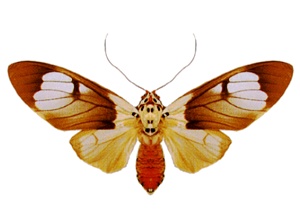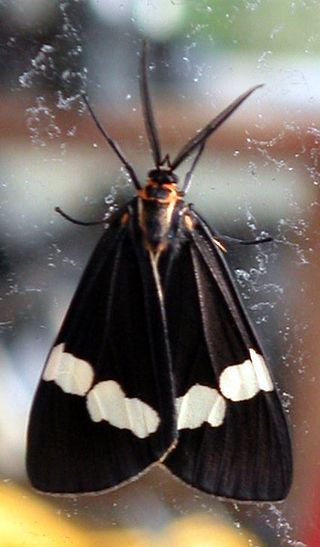
The Arctiinae are a large and diverse subfamily of moths with around 11,000 species found all over the world, including 6,000 neotropical species. This subfamily includes the groups commonly known as tiger moths, which usually have bright colours, footmen, which are usually much drabber, lichen moths, and wasp moths. Many species have "hairy" caterpillars that are popularly known as woolly bears or woolly worms. The scientific name Arctiinae refers to this hairiness. Some species within the Arctiinae have the word "tussock"' in their common names because they have been misidentified as members of the Lymantriinae subfamily based on the characteristics of the larvae.

Utetheisa is a genus of tiger moths in the family Erebidae. The genus was first described by Jacob Hübner in 1819.

The Phaegopterina are a subtribe of tiger moths in the tribe Arctiini, which is part of the family Erebidae. The subtribe was described by William Forsell Kirby in 1892. 469 species of Phaegopterina are present and 52 that are recently discovered in Brazil.

The Callimorphina are a subtribe of woolly bear moths in the family Erebidae. The subtribe was described by Francis Walker in 1865. Many of these moths are easily confused with butterflies, being quite brightly colored and somewhat diurnal. Their antennae are not thickened into "clubs", which is a typical characteristic of butterflies.

Amerila is a genus of moths in the subfamily Arctiinae.

Nebrarctia is a genus of moths in the family Erebidae from the Near East, Central Asia and Himalayas. The genus was erected by Otto Staudinger in 1891.
Paraspilarctia is a genus of moths in the family Erebidae. It occurs in China, Taiwan, and northern Vietnam.
Kishidaria is a genus of tiger moths in the family Erebidae.

The Nyctemerina are a subtribe of woolly bear moths in the family Erebidae.
Eyralpenus meinhofi is a polymorphic tiger-moth in the family Erebidae first described by Max Bartel in 1903. It is known from the east and central Africa: Tanzania, Zambia, Zambia, Angola, Zaire ; Malawi ; Zaire ; Zimbabwe.

Juxtarctia multiguttata is a polymorphic tiger-moth in the subfamily Arctiinae, endemic for Himalayas. It is known from India: north-west Himalayas, Sikkim, Assam; Nepal; Bhutan; Myanmar; China: Tibet within western slopes of the Himalayas; Indochina.
Madagascarctia is a genus of moths in the subfamily Arctiinae from Madagascar. The genus was erected by Vladimir Viktorovitch Dubatolov in 2006. As per David T. Goodger and Allan Watson (1995) the species of this genus have whitish wings speckled with brown.
Pericaliella is a genus of moths in the subfamily Arctiinae that is known from the Afrotropics. It includes one species Pericaliella melanodisca from Cameroon, Zaire, Uganda and Rwanda.

Amerila astreus is a moth of subfamily Arctiinae described by Dru Drury in 1773. It is found from the Oriental region to New Guinea. The species is found in primary and secondary habitats ranging from lowlands to montane regions.

Mangina is a genus of tiger moths in the family Erebidae.
Amerila eugenia is a moth of the subfamily Arctiinae. It was described by Johan Christian Fabricius in 1794. It is found in China, Pakistan (Karachi), central and southern India and Sri-Lanka.
Amerila lactea is a moth of the subfamily Arctiinae. It was described by Walter Rothschild in 1910. It is found in Myanmar and Nepal.
Amerila rhodopa is a moth of the subfamily Arctiinae. It was described by Francis Walker in 1865. It is found in India.
Argyarctia sericeipennis is a moth of the family Erebidae. It was described by Rothschild in 1933. It is found in China (Yunnan).
Utetheisa ampatica is a moth in the family Erebidae. It was described by Rob de Vos in 2007. It is found in Papua New Guinea, where it has been recorded from the Raja Ampat Islands of Salawati and Waigeo.











